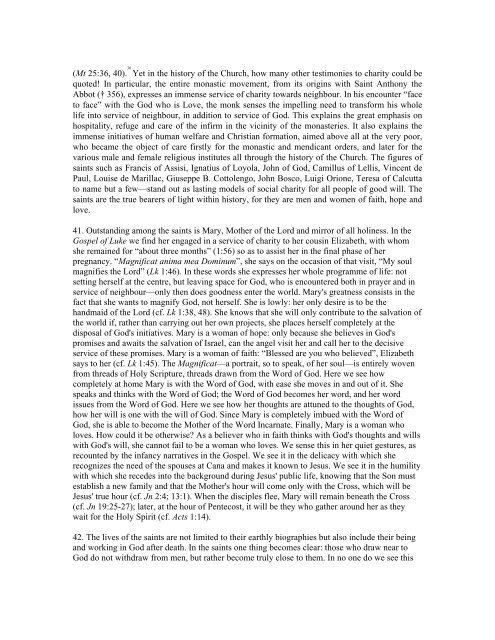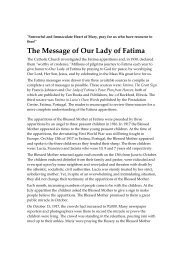God Is Love - Beeldbibliotheek
God Is Love - Beeldbibliotheek
God Is Love - Beeldbibliotheek
- No tags were found...
Create successful ePaper yourself
Turn your PDF publications into a flip-book with our unique Google optimized e-Paper software.
(Mt 25:36, 40). 36 Yet in the history of the Church, how many other testimonies to charity could bequoted! In particular, the entire monastic movement, from its origins with Saint Anthony theAbbot († 356), expresses an immense service of charity towards neighbour. In his encounter “faceto face” with the <strong>God</strong> who is <strong>Love</strong>, the monk senses the impelling need to transform his wholelife into service of neighbour, in addition to service of <strong>God</strong>. This explains the great emphasis onhospitality, refuge and care of the infirm in the vicinity of the monasteries. It also explains theimmense initiatives of human welfare and Christian formation, aimed above all at the very poor,who became the object of care firstly for the monastic and mendicant orders, and later for thevarious male and female religious institutes all through the history of the Church. The figures ofsaints such as Francis of Assisi, Ignatius of Loyola, John of <strong>God</strong>, Camillus of Lellis, Vincent dePaul, Louise de Marillac, Giuseppe B. Cottolengo, John Bosco, Luigi Orione, Teresa of Calcuttato name but a few—stand out as lasting models of social charity for all people of good will. Thesaints are the true bearers of light within history, for they are men and women of faith, hope andlove.41. Outstanding among the saints is Mary, Mother of the Lord and mirror of all holiness. In theGospel of Luke we find her engaged in a service of charity to her cousin Elizabeth, with whomshe remained for “about three months” (1:56) so as to assist her in the final phase of herpregnancy. “Magnificat anima mea Dominum”, she says on the occasion of that visit, “My soulmagnifies the Lord” (Lk 1:46). In these words she expresses her whole programme of life: notsetting herself at the centre, but leaving space for <strong>God</strong>, who is encountered both in prayer and inservice of neighbour—only then does goodness enter the world. Mary's greatness consists in thefact that she wants to magnify <strong>God</strong>, not herself. She is lowly: her only desire is to be thehandmaid of the Lord (cf. Lk 1:38, 48). She knows that she will only contribute to the salvation ofthe world if, rather than carrying out her own projects, she places herself completely at thedisposal of <strong>God</strong>'s initiatives. Mary is a woman of hope: only because she believes in <strong>God</strong>'spromises and awaits the salvation of <strong>Is</strong>rael, can the angel visit her and call her to the decisiveservice of these promises. Mary is a woman of faith: “Blessed are you who believed”, Elizabethsays to her (cf. Lk 1:45). The Magnificat—a portrait, so to speak, of her soul—is entirely wovenfrom threads of Holy Scripture, threads drawn from the Word of <strong>God</strong>. Here we see howcompletely at home Mary is with the Word of <strong>God</strong>, with ease she moves in and out of it. Shespeaks and thinks with the Word of <strong>God</strong>; the Word of <strong>God</strong> becomes her word, and her wordissues from the Word of <strong>God</strong>. Here we see how her thoughts are attuned to the thoughts of <strong>God</strong>,how her will is one with the will of <strong>God</strong>. Since Mary is completely imbued with the Word of<strong>God</strong>, she is able to become the Mother of the Word Incarnate. Finally, Mary is a woman wholoves. How could it be otherwise? As a believer who in faith thinks with <strong>God</strong>'s thoughts and willswith <strong>God</strong>'s will, she cannot fail to be a woman who loves. We sense this in her quiet gestures, asrecounted by the infancy narratives in the Gospel. We see it in the delicacy with which sherecognizes the need of the spouses at Cana and makes it known to Jesus. We see it in the humilitywith which she recedes into the background during Jesus' public life, knowing that the Son mustestablish a new family and that the Mother's hour will come only with the Cross, which will beJesus' true hour (cf. Jn 2:4; 13:1). When the disciples flee, Mary will remain beneath the Cross(cf. Jn 19:25-27); later, at the hour of Pentecost, it will be they who gather around her as theywait for the Holy Spirit (cf. Acts 1:14).42. The lives of the saints are not limited to their earthly biographies but also include their beingand working in <strong>God</strong> after death. In the saints one thing becomes clear: those who draw near to<strong>God</strong> do not withdraw from men, but rather become truly close to them. In no one do we see this












